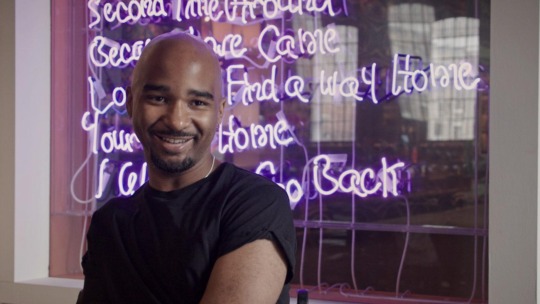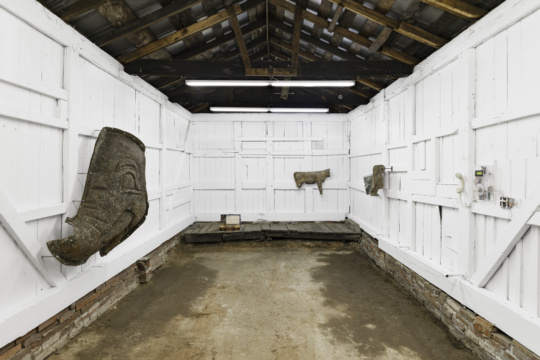
Today BURNAWAY welcomes Matt Bell for this month’s Authors on Art, a series of creative responses by poets, novelists, and experimental writers curated by Blake Butler.
His doctor remembered that he took no interest in making art until he encountered a fallen apple tree during a walk on the hospital grounds and asked for help in dragging it indoors and getting simple carving tools…For a month, the patient whittled the wood down to this figure. The artist, in his thirties, committed suicide about two years after leaving the hospital. This applewood figure is his only known work of art.
You can’t take pictures inside the museum, and until recently I couldn’t find any pictures of Recovery online. (There’s now one very small one on the Museum’s website.) Without being able to return easily (I live in Michigan) or to otherwise refresh my memories, the half-life of the experience approached and then passed: I’m never good at remembering visual detail, and it doesn’t take long for me to start letting my imagination fill in the blanks. Eventually I have only something less than the original object: more a sort of Rorschach blot designed in reverse, starting with the thing and ending with only its shadowy suggestion.

Sometime during the drafting, Recovery came back to me. I remembered how powerfully I’d felt a kind of longing while looking it, a want to be seen. I thought I’d projected into that sensed longing my idea of the creator’s want to make something lasting, a permanent memorial to a temporary thing: his own diseased and distressed flesh.
I wondered, What would it feel like to be such a person? And then: What would it feel like to be in the opposite situation, where the carver is the only one left, and it is his own fading memories he has to fight to preserve in wood?
In “Walker, Wallace, Warren,” my story inspired by my memories of Recovery, an amnesia-addled widower and carpenter narrates his situation: “All around me: only stilled wood, dead branches over dirty ground. Only this lonely world grown atop my buried children, my planted wife.”
He says, “With awl and adze, with hammer and chisel, I carve my oldest out of the first tree. I remake him as best I remember, shaping the roundness of his cheeks, grooving out the spaces between his teeth and toes.”
And later, after all his lost children are carved into the other trees of his orchard: “On the first day of fall, I cut my wife’s body free of the center-most trunk, using my tools to recreate the inverted ribs of her diseased chest, the long-ago smoothness of her oft-emptied belly. With every skill I’ve learned, I remember her upon the wood: her eyes exactly the proper shape and size, exactly the right tilt to complement the laughing smile last heard too long ago. Her nose alone I work on for days, slicing curl after curl off the bridge until it is the same nose whose tip I kissed goodbye every night, even at the end, when there was so little of it left.”
This carving of the wife’s image contained the most direct homage to Recovery. I could fit into the story, giving the narrator’s long-missed wife the same scarred chest the creator of the applewood figure had, the same smoothness everywhere else that makes that chest so striking when seen in person, preserved in the wood.
More than anything else, it was this contrast that had stayed with me, that I picture immediately when I try to bring Recovery to mind.
Now it’s almost all I can remember without prompting my own memory with the picture from the museum’s website.
He says, “It was not their names I loved. It is not their names I miss.”
Someday after we are gone, there will be no one who will remember our names either, no one who will speak for us, or tell honestly of who we were, of what we said or did. It’d feel like a tragedy if it wasn’t going to happen to all of us. Too often it still does feel tragic, because we want it to be different for us, because we believe ourselves the exception. But of course we’re not.
We can’t live forever, but we can perhaps live on a little longer, in just a few ways: by remaining in the memories of our families and friends, by entering the logs of history, by making a lasting work of art. The anonymous artist who carved Recovery is lost to us by name, or at least his name is not revealed. But something of what he was continues to resonate from that applewood figure. I know not everyone who sees it will extract as much feeling from it as I did, but surely some do. For them, perhaps the memory of what they’ve seen lasts for some time, changes them in some way, even if only temporarily. It’s not immortality but perhaps it’s the closest we can hope for. Perhaps it’s enough.
Matt Bell is the author of Cataclysm Baby, a novella, and How They Were Found, a collection of fiction. His debut novel In the House upon the Dirt between the Lake and the Woods will be published by Soho Press in Spring 2013. He is the Senior Editor at Dzanc Books, and teaches creative writing at Northern Michigan University.




